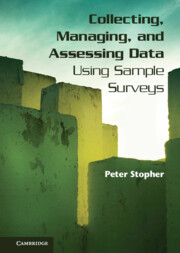Book contents
- Frontmatter
- Contents
- Figures
- Tables
- Acknowledgements
- 1 Introduction
- 2 Basic statistics and probability
- 3 Basic issues in surveys
- 4 Ethics of surveys of human populations
- 5 Designing a survey
- 6 Methods for conducting surveys of human populations
- 7 Focus groups
- 8 Design of survey instruments
- 9 Design of questions and question wording
- 10 Special issues for qualitative and preference surveys
- 11 Design of data collection procedures
- 12 Pilot surveys and pretests
- 13 Sample design and sampling
- 14 Repetitive surveys
- 15 Survey economics
- 16 Survey implementation
- 17 Web-based surveys
- 18 Coding and data entry
- 19 Data expansion and weighting
- 20 Nonresponse
- 21 Measuring data quality
- 22 Future directions in survey procedures
- 23 Documenting and archiving
- References
- Index
13 - Sample design and sampling
Published online by Cambridge University Press: 05 June 2012
- Frontmatter
- Contents
- Figures
- Tables
- Acknowledgements
- 1 Introduction
- 2 Basic statistics and probability
- 3 Basic issues in surveys
- 4 Ethics of surveys of human populations
- 5 Designing a survey
- 6 Methods for conducting surveys of human populations
- 7 Focus groups
- 8 Design of survey instruments
- 9 Design of questions and question wording
- 10 Special issues for qualitative and preference surveys
- 11 Design of data collection procedures
- 12 Pilot surveys and pretests
- 13 Sample design and sampling
- 14 Repetitive surveys
- 15 Survey economics
- 16 Survey implementation
- 17 Web-based surveys
- 18 Coding and data entry
- 19 Data expansion and weighting
- 20 Nonresponse
- 21 Measuring data quality
- 22 Future directions in survey procedures
- 23 Documenting and archiving
- References
- Index
Summary
Introduction
In Chapter 3 of this book, the basic concern of sampling was introduced as being that of achieving a representative sample. Furthermore, that chapter introduced the idea of probability sampling, and put forward the concept of the equal probability of selection method as the basis for representative sample creation. The purpose of this chapter is to explore how to design a sample and how to determine the sample size that is required for a particular survey. Moreover, this chapter elaborates on the notion of sampling error and develops the statistical procedures required to estimate the amount of sample error in a survey.
Prior to embarking on the statistical aspects of sample design, there are a few issues that must be dealt with. First, there is the definition and description of sampling frames. Next, this chapter considers what comprises a sampling procedure, within which is also described a popular process for generating a random telephone sample, namely random digit dialling. Sampling procedures in general are then discussed. Following this, a number of equal and unequal probability methods of sampling are dealt with, in which the statistical procedures for estimating population means and totals, proportions, and ratios, the estimation of sampling errors for each sampling method, and methods to determine the sample sizes required for a pre-specified level of accuracy are all laid out.
- Type
- Chapter
- Information
- Collecting, Managing, and Assessing Data Using Sample Surveys , pp. 265 - 336Publisher: Cambridge University PressPrint publication year: 2012



